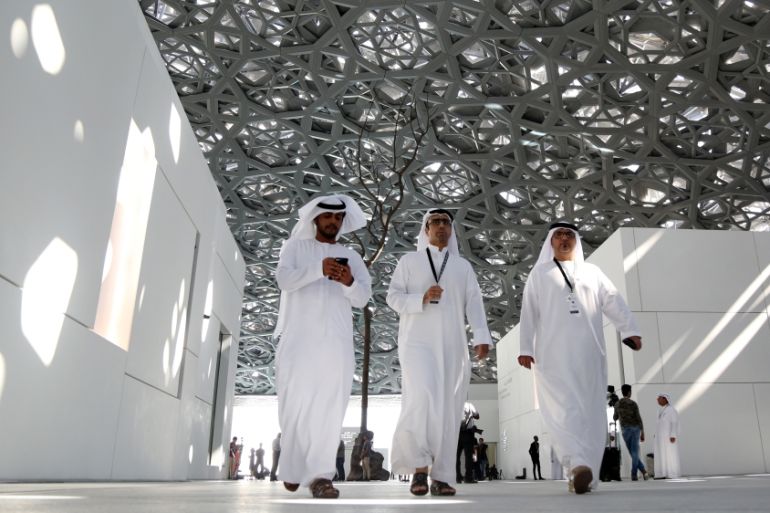HRW: Louvre Abu Dhabi ‘tainted’ by worker abuse
France director of rights group says the new Louvre Abu Dhabi museum was accomplished at the cost of human suffering.

A human rights group has described the new Louvre Abu Dhabi Museum as being “tainted” with gross rights violations committed against migrant workers on the building site.
The immense project, which took 10 years to build to the tune of $1bn, was officially inaugurated by French President Emmanuel Macron. It will open to the public on Saturday.
Keep reading
list of 4 itemsMasked Tunisian police arrest prominent lawyer for media comments
Gaza’s mass graves: Is the truth being uncovered?
Tunisia: The migration trap
Benedicte Jeannerod, the France director at Human Rights Watch(HRW), said that while many consider the museum to be a “technical and aesthetic feat”, the building holds a more unpleasant back story.
“It has been accomplished at the cost of human suffering, in a country whose rulers appear to still widely despise human rights and suppress any critical voice,” she said.
Worker rights abuse
Before the rights group was banned from entering the country in 2014, HRW published three reports on construction sites of Saadiyat Island, including one on the Louvre Abu Dhabi.
The reports documented a range of human rights violations against migrant workers, who make up more than 90 percent of the United Arab Emirates’ private workforce.
The most recent report, published in February 2015, shed light on “unsafe working conditions leading to workplace accidents and deaths, passport confiscations, appalling living and housing conditions, extremely low wages, or sometimes non-payment of wages”.
Moreover, these workers are held hostage to “Kafala”, the notorious sponsorship system that grants employers extreme powers over their employees. Workers have been arbitrarily deported for exercising their right to strike, and barred from re-entering the UAE.
While Jeannerod acknowledged that, because of international pressure, there have been “positive legislative developments” such as the reformation of the Kafala system and new workers’ rights rulings enacted, it remains difficult to measure progress.
“It remains extremely difficult to assess the impact of these laws on migrant workers’ lives and on their working conditions,” she said.
“The crackdown on civil society is so severe that activists have been silenced and few workers dare to voice their concerns.”
The new Louvre
The Emirati government has been busy transforming Saadiyat Island, which has an area of 27 square miles, into a new cultural hub. The island is already home to a campus for New York University, and, in addition to the Louvre, two other major international museums, including the Guggenheim.
According to a deal made between France and the UAE in 2007, the Louvre in Paris agreed to attach its name to the new museum in Abu Dhabi for a reported $520m.
The new Louvre, which was designed by French architect Jean Nouvel, has 600 artworks from around the world on permanent display, with a further 300 loaned from France. In addition to its 55 rooms and 23 permanent galleries, there is also a children’s museum and a research centre.
One of the exceptional features of the museum’s building is the latticed dome, which is made up of 7,850 aluminium stars and weighs more than 7,700 tonnes.
Entrance tickets are priced at $16.80 and have all sold out.